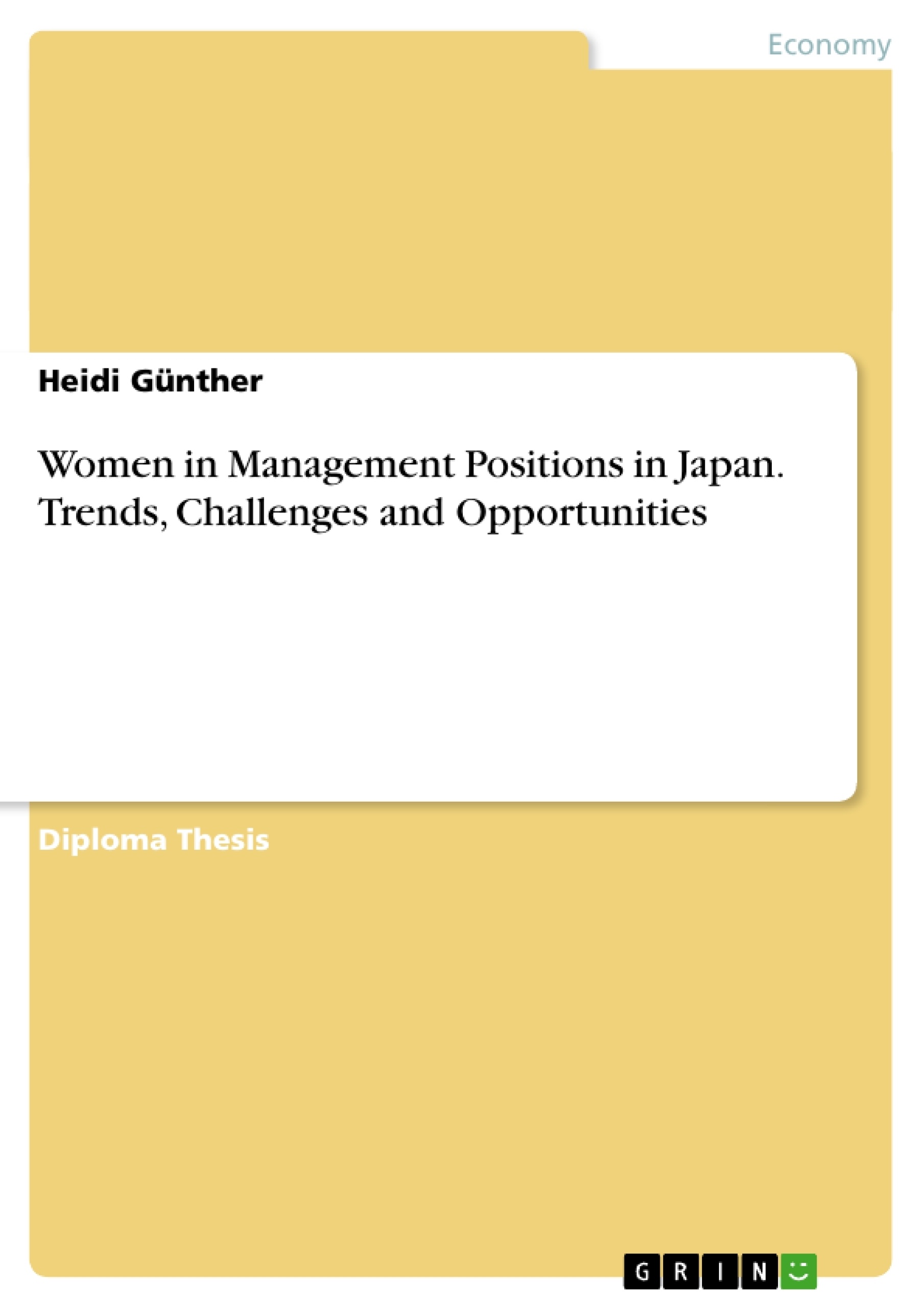The representation of women in management is a globally and frequently discussed phenomenon. Albeit the worldwide number of female managers is continuously increasing, progress is still slow and full of barriers (ILO, 2004). These obstacles are described as an invisible glass ceiling: Negative attitudes and prejudices within organizations prevent women from climbing the career ladder (Wirth, 2001). However, culture seems to be an important factor of influence for female management opportunities. For example, female managers tend to be generally less accepted in Asia than in America or Eastern Europe (ILO, 2004). Among Asian countries, Japan is very special: Although the country is one of the most developed and richest economies in the world, gender equality is extremely low there (UNDP, 2007; Fackler, 2007). Women are often hired for administrative tasks only and not allowed to pursue own careers. Despite growing attempts to strengthen gender equality, Japanese females are still discriminated against and expected to stick to their traditional duties as mothers, wives, and “office flowers” (Faiola, 2007; Ogasawara, 1998). Female under-representation is notably high for management positions and seems to increase with the level of seniority (Wirth, 2001). Consequently, the Japanese glass ceiling is also known as “concrete ceiling” reflecting the enormous level of gender discrimination (Wahlin, 2007; Penketh, 2008).
Japan’s rigid and outstanding gender inequality is strongly influenced by the national culture and its major impact on the societal role of women. On the one hand, the Japanese are known for their ability to change but on the other hand, they always try to maintain their special Japanese identity within every aspect of life. Thus, fixed gender roles of men as breadwinners and women as housewives persist even in spite of growing internationalization (Haak & Haak, 2006). Nevertheless, environmental changes like an aging and decreasing population force Japanese companies to accept females as part of the talent pool (Fackler, 2007; Otake, 2008).
According to these facts, female managers in Japan turn out to be an exciting field of research: They are needed but also discriminated against at the same time. The objective of this diploma thesis is to examine current trends and to analyze challenges as well as existing opportunities to improve their situation.
Inhaltsverzeichnis (Table of Contents)
- Introduction
- The Japanese Culture - Characteristics and Influence on Women
- Cultural Patterns
- Religion, Society & Economy
- Legal Background of Gender Equality
- Corporate Principles
- Quantitative Trends - Current Representation of Female Managers
- Japan's Position in the World
- Trends in Japan
- Qualitative Trends – Impressions about and from Japanese Women
- Interview Background
- Interview Results Structured by Question
- Challenges for Female Japanese Managers
- External Challenges
- Japanese Gender Roles, Stereotyping & Prejudices
- Legal and Governmental Determinants of Gender Inequality
- Lacking Support of Female Managers within Companies
- The Male Corporate Culture
- Human Resource Management (HRM)
- Internal Challenges
- Lack of Education
- Lack of Career Orientation
- External Challenges
- Opportunities to Improve the Situation of Female Managers in Japan
- Culture Change & Internationalization Tendencies
- Governmental Change Actions
- Organizational Change
- Changing HRM Policies
- Corporate Social Responsibility
- Personal Changes by Women
- Discover Female Strengths
- Learn from Female Role Models
- Conclusion & Outlook
Zielsetzung und Themenschwerpunkte (Objectives and Key Themes)
This work aims to examine the challenges faced by female managers in Japan and explore potential solutions to improve their situation. The text analyzes the complex interplay of cultural factors, societal norms, legal frameworks, and corporate practices that influence the representation of women in leadership positions within Japan. Key themes explored in this work include:- The impact of Japanese culture on women's roles and opportunities in the workplace.
- The challenges posed by gender inequality in Japanese society, both legally and culturally.
- The limitations faced by female managers within corporate structures and the role of Human Resource Management (HRM) in addressing these challenges.
- The importance of cultural change, governmental initiatives, and organizational transformations in creating a more equitable workplace for women.
- The role of individual women in overcoming internal challenges and advancing their careers.
Zusammenfassung der Kapitel (Chapter Summaries)
The introduction sets the stage for the discussion by outlining the global phenomenon of women's representation in management and highlighting the unique situation in Japan. The chapter explores the concept of the "glass ceiling" and its specific manifestation as a "concrete ceiling" in Japanese society. Chapter 2 delves into the characteristics of Japanese culture and its impact on women's roles. It examines cultural patterns, religious beliefs, societal norms, economic structures, and legal frameworks related to gender equality. Chapter 3 presents quantitative trends related to the current representation of female managers in Japan. It compares Japan's position in the global context and analyzes trends within the country itself. Chapter 4 shifts the focus to qualitative trends by exploring personal impressions about and from Japanese women. It presents insights gathered from interviews, highlighting individual experiences and perspectives on gender roles and management opportunities. Chapter 5 examines the challenges faced by female Japanese managers, categorizing them into external and internal challenges. The chapter discusses the influence of Japanese gender roles, stereotypes, legal constraints, and lack of support within companies, including the impact of the male corporate culture and HRM practices. Internal challenges include lack of education and career orientation. Chapter 6 explores opportunities for improvement, focusing on cultural change, governmental actions, and organizational transformations. It emphasizes the need for changes in HRM policies, corporate social responsibility, and personal development strategies for women.Schlüsselwörter (Keywords)
This work focuses on the issues of gender equality and female leadership in Japan. Key terms and concepts include: Japanese culture, gender roles, glass ceiling, concrete ceiling, corporate culture, Human Resource Management (HRM), corporate social responsibility, and female empowerment.- Citation du texte
- Heidi Günther (Auteur), 2008, Women in Management Positions in Japan. Trends, Challenges and Opportunities, Munich, GRIN Verlag, https://www.grin.com/document/135192



